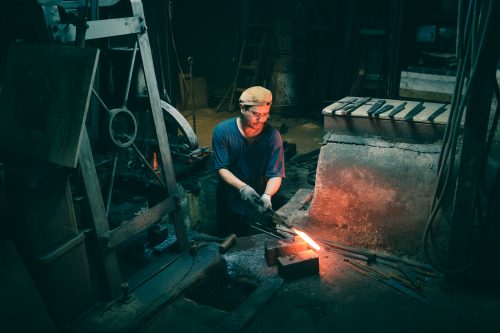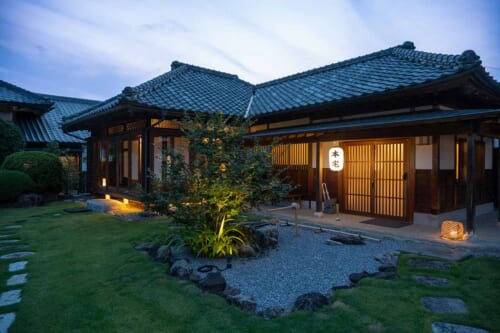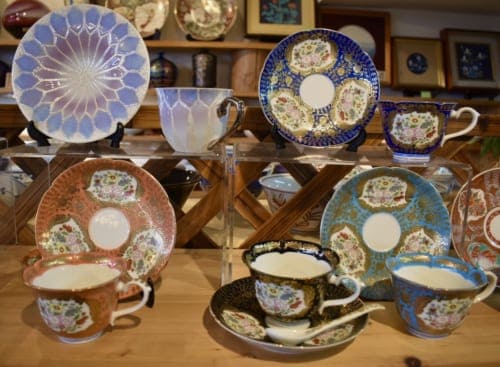Sponsored by Kinki District Transport Bureau
The reputation of Japanese knives, from their sharpness to their quality of craftsmanship, is world renowned. Iron working has been a skill Japanese blacksmiths have been refining since the 5th century, especially during the war fueled feudal periods when swords were in constant demand. When the sword trade began to dry up, the blacksmiths turned their skills and experience toward a more peaceful tool: kitchen knives. Sakai City in Osaka Prefecture is the birthplace of Japanese knives. Sakai has been making knives predating the use of metal; stone blades have been discovered dating back more than 2000 years. The techniques for knife making here are so renowned that 90% of the chefs in Japan are now using knives made in Sakai.

Mizuno Tanrenjo’s Hand-forged Knives
Sakai’s knives are handmade in forges that have been creating these utensils of art for centuries. The forge of Mizuno Tanrenjo is one of the forges in Sakai whose skill is known all over the globe. Founded in 1872, Mizuno forges exceptional blades with the sweat of his brow, day after day.


The process begins with a simple iron bar heated in a coal forge, and the blacksmith starts to hammer it into a rough form. But iron is a soft metal, so Mizuno will then meld it with steel, called hagane in Japanese.


The steel is much harder than iron and will form the cutting edge of the blade. The iron will protect the steel and give the blade good impact resistance. The whole piece is again heated to white hot and the shaping of the blade can begin.


Again and again, Mizuno warms the blade and flattens it gradually. He passes the blade under a pestle hammer, also called a martinet. The craftsman adjusts the speed and power of the mechanical hammer using a pedal that he operates with his foot. The blacksmith alternates between the use of his machine with the use of a simple hammer, which allows him greater precision.

The dull thud of the machine and hammer echo in the workshop. It is hot and the sweat flows continuously down the face of the blacksmith. What was initially a bar of iron is gradually taking the form of a knife, longer and thinner.

Finally the knife reaches its desired shape. The blade is heated one last time, then immersed in the water while it is still burning. This stage is called dipping and the sudden change in temperature will give strength to this newly forged blade. The blade is sharpened and polished to its final form.

On the right the blade that has just been forged and tempered, on the left the blade that serves as a model for the blacksmith
Beside forges, Mizuno Tanrenjo has a shop where you can admire his knives and purchase them. You can find more information on their website.


Learn to sharpen Japanese knives at Wada
An artisan from Sakai offers a workshop for visitors who would like to learn how to take care of their Japanese knives. The Wada knife shop was founded more than 150 years ago. For about 8000 yen, you can leave with a Japanese knife engraved with the characters of your choice and take part in the hour-long workshop.

Sharpening a blade (or reshaping a damaged blade) is actually quite simple. In this workshop, decades of knife care experience are passed on to you, and a translator is available for foreign customers who need one.

To restore the sharpness of a dull blade, you must rub the blade on a wet stone. Press firmly, but not too hard, paying attention to the angle of the blade on the stone. It’s a slow relaxing process you will repeat until it comes naturally, eventually moving to another stone with a finer surface. The result of your labor is a blade which slices through a newspaper with a whisper of pressure.

But the workshop does not end there. Knife retailers such as Wada buy both blades and handles from the manufacturers, making it possible to customize a blade with a specific handle. During the workshop, you also learn how to assemble a blade and its handle. Handles come in all types of shapes, colors, weights and materials.
The assembly process seemed fairly simple, but maybe this perception came from the unparalleled expertise of my master. At 92 years of age, the veteran of this shop has been working here for 70 years!

The narrow end of the naked blade is placed inside the handle. A few strokes with a hammer coax the blade to sink gently into the handle.

After receiving instructions and watching the master at work, you can assemble your own knife. Finally, you are the happy owner of a knife that you have both sharpened and assembled. All you have to do now is buy some fresh fish and practice cutting your own sashimi! For more information you can visit the Wada’s website.
Discover the history of cutlery and treat yourself to a traditional knife at the Sakai City Traditional Crafts Museum
The Sakai City Traditional Crafts Museum offers information on the rich history of the many Sakai City crafts. There is information on the making of incense, or the bike parts industry that is part of the history of the city, as well as an entire floor dedicated to knives.

A multitude of knives made for specific purposes are exhibited; for example, knives dedicated to cutting noodles soba or udon, and knives dedicated to certain types of fish or seafood. There are knives for everything!


The most impressive piece in the collection is probably the tuna sword. Used for cutting tuna, the most popular fish with the Japanese, the blade is huge and it usually takes two people to wield it. You can also admire some historical pieces, such as this sword which is several centuries old.

But more than a knife museum, it is also a special place to buy Japanese knives. The Mizuno forge we visited is one of only a handful Sakai artisans to own their own cutlery shop; the majority of Sakai’s blacksmiths have to sell their products through dealers. The Sakai City Traditional Crafts Museum is the only place where these artisans can sell their knives directly to consumers without going through an intermediary. A sharpening service on the ground floor even belongs to the association of Sakai cutlers. If you want to buy a traditional handmade knife, you will not only find a wide range of blades forged in Sakai, it is also a wonderful opportunity to support the local economy.

And you may meet a Frenchman there who can assist you! Eric Chevallier came to Japan to study under the blacksmith masters. After practicing as a blacksmith for five years, today he is the cultural ambassador for Sakai and is in charge of the industrial promotion of the city. He is often at the Sakai City Traditional Crafts Museum and is happy to share his passion for Japanese knives with visitors.













No Comments yet!